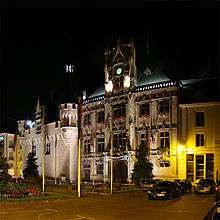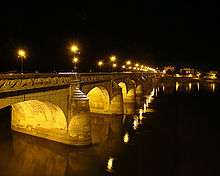Saumur
| Saumur | ||
|---|---|---|
|
| ||
| ||
 Saumur | ||
|
Location within Pays de la Loire region  Saumur | ||
| Coordinates: 47°15′36″N 0°04′37″W / 47.260000°N 0.0769°WCoordinates: 47°15′36″N 0°04′37″W / 47.260000°N 0.0769°W | ||
| Country | France | |
| Region | Pays de la Loire | |
| Department | Maine-et-Loire | |
| Arrondissement | Saumur | |
| Intercommunality | Saumur Loire Développement | |
| Government | ||
| • Mayor (2008–2014) | Michel Apchin | |
| Area1 | 66.25 km2 (25.58 sq mi) | |
| Population (2012)2 | 27,523 | |
| • Density | 420/km2 (1,100/sq mi) | |
| Time zone | CET (UTC+1) | |
| • Summer (DST) | CEST (UTC+2) | |
| INSEE/Postal code | 49328 / 49400 | |
| Elevation |
20–95 m (66–312 ft) (avg. 30 m or 98 ft) | |
|
1 French Land Register data, which excludes lakes, ponds, glaciers > 1 km² (0.386 sq mi or 247 acres) and river estuaries. 2 Population without double counting: residents of multiple communes (e.g., students and military personnel) only counted once. | ||
_1.svg.png)
_2.svg.png)
Saumur (French pronunciation: [so.myʁ]) is a commune in the Maine-et-Loire department in western France.
The historic town is located between the Loire and Thouet rivers, and is surrounded by the vineyards of Saumur itself, Chinon, Bourgueil, Coteaux du Layon, etc. which produce some of France's finest wines.
Its skyline has often been compared with that of Bratislava, the capital of Slovakia.
History
Early settlement of the region goes back many thousands of years. The Dolmen de Bagneux on the south of the town, is 23 meters long and is built from 15 large slabs of the local stone, weighing over 500 tons. It is the largest in France.
The Château de Saumur was constructed in the 10th century to protect the Loire river crossing from Norman attacks after the settlement of Saumur was sacked in 845. The castle, destroyed in 1067 and inherited by the House of Plantagenet, was rebuilt by Henry II of England in the later 12th century. It changed hands several times between Anjou and France until 1589.
Houses in Saumur are constructed almost exclusively of the beautiful, but fragile, Tuffeau stone. The caves dug to excavate the stone have become tunnels and have been used by the local vineyards as locations to store their wines.[1]
Amyraldism, or the School of Saumur, is the name used to denote a distinctive form of Reformed theology taught by Moses Amyraut at the University of Saumur in the 17th century. Saumur is also the scene for Balzac's novel Eugénie Grandet, written by the French author in 1833, and the title of a song from hard rock band Trust (whose lyrics express their poor opinion of the city: narrow-minded, bourgeois and militaristic).
Prior to the French Revolution Saumur was the capital of the Sénéchaussée de Saumur, a bailiwick, which existed until 1793. Saumur was then the location of the Battle of Saumur during the Revolt in the Vendée. Becoming a state prison under Napoleon Bonaparte. The town was an equestrian centre with both the military cavalry school from 1783 and later the Cadre Noir based there.
World War II
During the Battle of France, in World War II, Saumur was the site of the Battle of Saumur (1940) where the town and south bank of the Loire was defended by the teenage cadets of the cavalry school, to their great credit and for the Honour of France.[2]
In 1944 it was the target of Tallboy and Azon bombing raids by Allied planes. The first raid, on 8/9 June 1944,[3] was against a railway tunnel near Saumur, seeing the first use of the 12,000 lb Tallboy "earthquake" bombs. The hastily organized night raid was to stop a planned German Panzer Division, travelling to engage the newly landed allied forces in Normandy. The panzers were expected to use the railway to cross the Loire. No. 83 Squadron RAF illuminated the area with flares by four Avro Lancasters and marked the target at low level by three de Havilland Mosquitos. 25 Lancasters of No. 617 Squadron RAF, the "Dambusters" then dropped their Tallboys from 18,000 ft with great accuracy. They hit the approaches to the bridge, blocked the railway cutting and one pierced the roof of the tunnel, bringing down a huge quantity of rock and soil which blocked the tunnel, badly delaying the German reinforcements moving towards Normandy, especially 2nd SS Panzer Division Das Reich.[4][5] The damaged tunnel was quickly dug out to make a deeper cutting, resulting in the need for a second attack.
On 22 June, nine Consolidated B-24 Liberators of the United States Army Air Forces used the new Azon 1,000 lb glide bombs against the Saumur rail bridge;[6] escorted by 43 North American P-51 Mustangs. They failed to destroy the bridge. During the morning of 24 June, 38 American Boeing B-17 Flying Fortresses with conventional bombs attacked the bridge; escort was provided by 121 of 135 P-51s.[6] The bridge was damaged.
The town of Saumur was awarded the Croix de Guerre with palm for its resistance and display of French patriotism during the war.
Demographics
| |||||||||||||||||||||||||||
| |||||||||||||||||||||||||||
| |||||||||||||||||||||||||||
| |||||||||||||||||||||||||||
Main sights
Saumur is home to the Cadre Noir,[9] the École Nationale d'Équitation (National School of Horsemanship), known for its annual horse shows, as well as the Armoured Branch and Cavalry Training School, the officer school for armored forces (tanks).
There is the national tank museum, the Musée des Blindés, with more than 850 armored vehicles, wheeled or tracked. Most of them are from France, though some come from other countries such as Brazil, Germany, and the Soviet Union, as well as axis and allied vehicles of World War Two.
The annual military Carrousel takes place in July each year, as it has done for over 160 years, with displays of horse cavalry skills, historic and modern military vehicles.[10]
Amongst the most important monuments of Saumur are the great Château de Saumur itself which stands high above the town, and the nearby Château de Beaulieu which stands just 200 metres from the south bank of the Loire river and which was designed by the architect Jean Drapeau. A giant sequoia tree (which is protected) stands in the grounds of Château de Beaulieu. The Dolmen de Bagneux is on the old road going south.
The architectural character of the town owes much to the fact that it is constructed almost exclusively of the beautiful, but fragile, Tuffeau stone.[11]
The wine industry surrounds Saumur, many utilising the tunnels as cellars with the hundreds of domaines producing white, red, rosé and sparkling wines. Visits to producers and the annual Grandes Tablées du Saumur-Champigny is a popular annual event held in early August with over 1km of tables set up in Saumur so people can sample the local foods and wine.[12]
Saumur has a famous weekly market. Every Saturday morning with hundreds of stalls open for business in the streets and squares of the old town, from before 8am.
Notable people
Saumur was the birthplace of:
- Anne Le Fèvre Dacier (1654–1720), scholar and translator of classics
- Jeanne Delanoue (1666-1736), made a Roman Catholic Saint in 1982
- François Bontemps (1753–1811), General of the French Revolutionary Wars.
- Charles Ernest Beulé (1826–1874), archeologist
- Coco Chanel (1883–1971), fashion designer
- Yves Robert, (1920–2002), actor, composer, director, writer, producer
- Jack le Goff (1931-2009), equestrian
- Fanny Ardant, (b. 1949), actress
- Dominique Pinon, (b. 1955), actor
- Youna Dufournet. (b. 1993), French artistic gymnast
The French mathematician Abraham de Moivre initially studied logic at Saumur.
Marquis de Sade was briefly imprisoned in the Château de Saumur (then a prison) in 1768.
Twin towns
The town is twinned with:
- Asheville, NC, United States
- Havelberg, Germany[13]
- Ruşeţu, Romania[14]
- Verden, Germany
- Warwick, United Kingdom[15]
See also
References
- ↑ "Megaliths in France". cromwell-intl.com.
- ↑ Macnab, Roy. For Honour Alone. Robert Hale. ISBN 978-0709033318.
- ↑ "Saumur Tunnel, 9th June 1944". Royal Air Force Bomber Command 60th Anniversary. UK Crown. Retrieved 2007-05-24.
- ↑ "Campaign Diary June 1944". Royal Air Force Bomber Command 60th Anniversary. UK Crown. Retrieved 2007-05-24.
- ↑ Saumur Railway Tunnel dambusters.org.uk quoting AIR27/2128
- 1 2 "8th Air Force 1944 Chronicles". Archived from the original on 12 September 2007. Retrieved 2007-05-25.
- ↑ http://cassini.ehess.fr/ Population by city before 1962 (results published on official journals or conserved in departmental archives)
- ↑ INSEE : Population since the census of 1962
- ↑ Official Website of The French national horse riding school. "The French national horse riding school".
- ↑ "LE CARROUSEL DE SAUMUR". Saumur.
- ↑ Augustus John Cuthbert Hare (1890). South-western France. G. Allen. pp. 84–. Retrieved 21 February 2011.
- ↑ ""Les Grandes Tablées du Saumur-Champigny" à Saumur". france.fr.
- ↑ "Saumur (Frankreich)". havelberg.de.
- ↑ "Ruşeţu – satul de pe domeniul Coroanei României". gazetalubuzoianu.
- ↑ "TWINNING". warwicktowncouncil.
External links
| Wikimedia Commons has media related to Saumur. |
- Official website (in French)
- Notre Dame des Ardilliers - Article in the Catholic Encyclopedia about a Catholic pilgrimage center in the town
- Tank Museum of Saumur (Musée des Blindés)
- Chateau de Beaulieu
- Les séquoias géants en Pays-de-la-Loire
- Chateau of Saumur (in French)
- Cadre Noir
- Saumur Cricket Club

